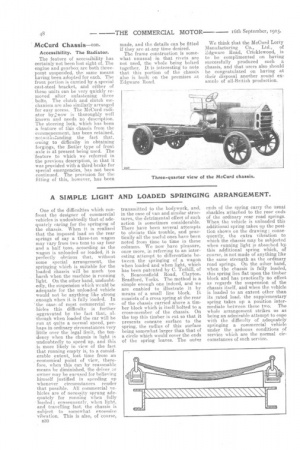A SIMPLE LIGHT AND LOADED SPRINGING ARRANGEMENT.
Page 8

If you've noticed an error in this article please click here to report it so we can fix it.
One of the difficulties which confront the designer of commercial vehicles is undoubtedly that of adequately caring for the springing of the chassis. When it is realized
• that the imposed load on the rear springs of say a three-ton wagon may vary from two tons to say four and a half tons, according as the wagon is unloaded or loaded, it is perfectly obvious that, without some special arrangement, the springing which is suitable for the loaded chassis will be much too . harsh when the machine is running light. On the other hand, undoubtedly, the suspension which would be adequate for the unloaded vehicle would not be anything like strong enough when it is fully loaded_ In the case of most commercial vehicles this difficulty is further aggravated by the fact that, al'though when loaded the car will be run at quite a normal speed, perhaps in ordinary circumstances very :little over the legal limit, the tendency when the chassis is light is undoubtedly to speed up, and this is more likely in view of the fact that running empty is, to a considerable extent, lost time from an . economical point of view, therefore, when this can by reasonable means be diminished, the driver or owner may be excused for believing himself justified in speeding up whenever circumstances render that possible. All commercial vehicles are of necessity sprung adequately for running when . fully loaded ; consequently, when light, and travelling fast, the chassis is subject to somewhat excessive vibration. This is also, of 'course, B30 transmitted to the bodywork, and., in the case of van and similar structures, the detrimental effect of such action is sometimes considerable. There have been several attempts to obviate this trouble, and practically all the useful ones have been noted from time to time in these columns. We now have pleasure, once more, in referring to an interesting attempt to differentiate between the springing of a wagon when loaded and when light, which has been patented by C. Tothill, of 8, Beaconsfield Road, Clayton, Bradford, Yorks. The method is a simple enough one indeed, and we are enabled to illustrate it by means of a small line block, It consists of a cross spring at the rear of the chassis carried above a timber block which is itself bolted to a cross-member of the chassis. On the top this timber is cut so that it presents concave surface to the spring, the radius of this surface being somewhat larger than that of a circle which would cover the ends of the spring leaves. The outer ends of the spying carry the usual shackles attached to the rear ends of the ordinary rear road springs. When the vehicle is unloaded this additional spring takes up the posi, tion shown on the drawing ; consequently, the extra vibration to which the chassis may be subjected when running light is absorbed by this additional spring which, of course, is not made of anything like the same strength as the ordinary road springs. On the other hand; when the chassis is fully loaded, this spring lies flat upon the timber block and has practically no effect as regards the suspension of the chassis itself, and when the vehicle is loaded to an extent other than its rated load, the supplementary spring takes up a position intermediate between these two. The whole arrangement strikes us as being an admirable attempt to cope with the difficulty of adequately springing a commercial vehicle under the arduous conditions of service which are the normal circumstances of such service.




















